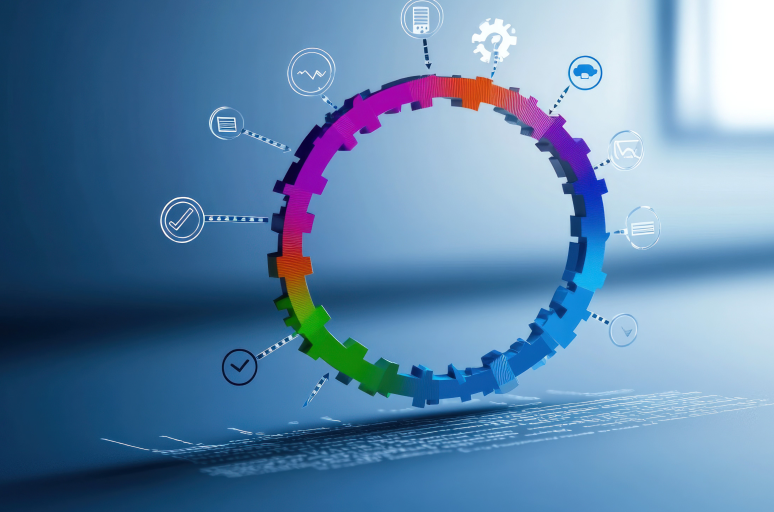Have you heard the saying “satisfied customers are your best advertisement”? Or perhaps this one: “Customer satisfaction is the ultimate strategy”? We're sure you have.
Why is this motto so popular, even among renowned figures like Bill Gates and Richard Branson? Can you really quantify a concept that seems intangible? And how can you enhance customer satisfaction?
Since the early 1970s, when satisfaction surveys were first introduced in the automotive industry, this topic has become a trending focus in all customer-facing businesses.
What is customer satisfaction?
If you were to ask a random group of people about “customer satisfaction”, they would likely discuss the level of happiness a customer has with a particular product. However, the concept is much more complex.
There are two widely accepted definitions. Paul Ferris, the renowned author of the book Marketing Metrics, defines it as “the number of customers, or the percentage of total customers, whose reported experience with a firm, its products, or its services exceeds specified satisfaction goals”.
Philip Kotler's interpretation could also be useful. He defines customer satisfaction as “a person's feeling of pleasure or disappointment that arises from comparing a product's perceived performance or outcome against their expectations”.
Regardless of which definition you find more appealing, customer satisfaction can be simplified to one thing: an assessment of the customer experience.
Why should you measure customer satisfaction?
It is essential for software companies to gather customer satisfaction data for several reasons:
- To enhance the product: customer feedback can identify areas where the software needs improvement, bugs need fixing, or new features should be added. Understanding user experiences helps prioritize development efforts.
- To ensure customer retention and loyalty: satisfied customers are more likely to continue using the app, renew subscriptions, upgrade to premium versions, and purchase additional functionalities and items.
- To boost marketing: satisfied customers often become advocates for the software, helping promote it to others.
- To differentiate the product: in crowded markets with many similar products, high customer satisfaction levels enable brands and companies to stand out and be remembered.
- To prevent reputation crises: negative feedback can quickly spread online. Monitoring customer satisfaction allows companies to address issues promptly and avoid potential reputation damage.
- To improve efficiency: this is particularly crucial in areas like customer support and software updates.
- To shape company strategy: this includes determining market position, managing the product portfolio, and establishing pricing policies.
- To increase customer lifetime value: satisfied customers are more likely to invest more money in your software over time.
- To facilitate customer acquisition: understanding the current level of customer satisfaction allows companies to refine their products to attract new customers.
- To drive sales and revenue: customer satisfaction directly impacts the economic parameters of your company, making it vital for increasing sales and revenue.
6 customer satisfaction metrics you should measure
Here is a list of the most frequently used customer satisfaction metrics you should consider in order to ensure customer satisfaction with your software product.
Customer Satisfaction Score (CSAT)
The Customer Satisfaction Score (CSAT) is a commonly used metric to evaluate the overall satisfaction of customers with a specific software.
How is customer satisfaction measured using CSAT?
Typically, the CSAT index is assessed through a single-question survey that asks respondents to rate their satisfaction level with the product.
The question should be straightforward, such as “How satisfied are you with the app?” Respondents are usually provided with a scale from 1 to 5, where 1 represents very unsatisfied and 5 represents very satisfied.
The CSAT score is determined by calculating the percentage of respondents who selected the highest levels of satisfaction (4 and 5) out of the total number of respondents. For example, if 83 out of 100 respondents were satisfied or very satisfied, the CSAT score would be 83%.
While the CSAT method provides an overview of the overall consumer satisfaction level, it may not provide the most valuable insights. Therefore, additional metrics often accompany it.
Customer Effort Score (CES)
The CES survey is frequently conducted alongside the CSAT. The Customer Effort Score measures the ease with which customers can achieve their desired results when interacting with a product. It quantifies the amount of effort customers have to exert in order to accomplish a specific goal, action, or task. Companies use this method to minimize customer effort, believing that a smoother customer journey leads to greater loyalty and satisfaction.
Similar to the CSAT, customers are asked one or two simple questions, such as “How easy was it for you to accomplish this task?” or “To what extent do you agree with the statement: the task was easy for me to accomplish?”. They are then asked to rate their response on a scale from 1 (very difficult) to 5 (very easy).
The CES is calculated by averaging all the respondent scores.
Net Promoter Score (NPS)
The Net Promoter Score (NPS) measures customer loyalty and the likelihood of customer recommendations. This metric classifies respondents into three groups.
- Customers who give a score between 0 and 6 are considered “detractors”. They are dissatisfied and may actively discourage others from using the product.
- Customers who give a score of 7 or 8 and are not enthusiastic enough to recommend the app are referred to as “passives”.
- The “promoters” are customers who give a score of 9 or 10 and are considered loyal and satisfied customers, who are likely to recommend your software.
Customer Retention Rate (CRR)
The Customer Retention Rate is a metric used to gauge the percentage of customers a company retains over a specific time period. It offers valuable insights into customer loyalty and, as a result, overall customer satisfaction. A high retention rate indicates that your company is effectively sustaining customer satisfaction.
To measure CRR, use the following formula: ((E-N) ÷ S) x 100 = CRR
S = number of customers at the start of the period
E = number of customers at the end of the period
N = number of customers acquired
How does it work in practice? Let's assume that you begin the month with 200 customers. Throughout the month, you acquire 20 new users and lose 10. Now, let's input these numbers into the formula:
[(210 – 20) ÷ 200] x 100 = CRR
(190 ÷ 200) x 100 = CRR
0.95 × 100 = CRR
95 = CRR
Your CRR would be 95%. We should note that this is a commendable result for software. It can vary significantly depending on the industry, but the average CRR after 30 days is around 77%.
Remember, if customer satisfaction is king, then customer loyalty is god.
- The likelihood of selling to an existing customer is 3–35 times higher than selling to a new customer.
- Acquiring a new customer can cost up to 7 times more than retaining an existing one.
- 65% of a company's business comes from its existing customers.
- Increasing customer loyalty by just 5% can boost profits by 20-95%.
- Loyal customers spend, on average, 67% more than new customers.
- Customers who have already made a purchase from a company are 50% more likely to purchase new products.
Feeling convinced now?
SERVQUAL
The term “SERVQUAL” is derived from “SERVice QUALity”, and is a well-known, widely-used framework for evaluating the quality of service provided in various industries. This model identifies discrepancies between client expectations and actual experiences.
SERVQUAL consists of five dimensions, also known as RATER:
- Reliability: the ability to consistently provide accurate and dependable service.
- Assurance: the expertise, courtesy, and ability of staff to inspire trust and confidence.
- Tangibles: personnel, equipment, visual appeal of communication materials, and physical facilities.
- Empathy: the customer care and individual attention provided by the company.
- Responsiveness: the willingness of staff to assist customers and provide prompt service.
To assess the level of service quality using SERVQUAL, customers are typically surveyed and asked to evaluate their expectations compared to their perceptions of each dimension. The difference between these two parameters represents a service quality gap.
A positive gap indicates that perceptions exceed expectations (indicating good service quality), while a negative gap suggests that the service falls short of expectations (indicating poor service quality).
Churn rate
The churn rate, also referred to as the attrition rate, is a metric that indicates how frequently customers cease using your software within a specific time frame. Churn is primarily measured in the SaaS industry and subscription-based services.
The churn rate is calculated using the following formula:
(churned customers ÷ total customers at the beginning of the time period) x 100
Looking for a real-world example? If an app starts the month with 1,000 subscribers and loses 50 by the end of the month, its churn rate for that 30-day period would be 5%.
Once again, the churn rate can vary depending on the industry. A favorable churn rate for subscription services typically falls between 2% and 8%. It may come as a surprise that B2B churn rates are approximately 2% lower than those in B2C, given that the former involves a more intricate and deliberate purchasing process. B2B companies that boast the lowest churn rates include Slack (<1%) and Zoom (<1%). Netflix (3.4%), Disney+ (3.7%), and Spotify (3.9%) have achieved remarkable results in the B2C realm.
How to improve customer satisfaction
You already know how to measure customer satisfaction metrics. Now, let’s discuss how to improve them.
Step 1: Gather customer satisfaction data
To gather customer satisfaction data, utilize CSAT, CES, CRR, or any of the other methods mentioned above, or preferably, a combination of them. Additionally, consider employing other tools such as one-to-one interviews, focus groups, online reviews, and social media monitoring.
It is also important to gather information from the sales team. Some companies even establish advisory boards comprised of their most loyal customers.
You can also utilize tools like Google Analytics or Mixpanel. User behavior, drop-off points, and engagement metrics provide the most valuable evidence of customer satisfaction or lack thereof.
Regardless of the methodology you choose, ensure that the process is easy and convenient for customers.
Step 2: Understand customer journey touchpoints and their effects
Touchpoints are the points of interaction between users and your product, whether direct or indirect.
The customer journey encompasses all of these touchpoints, collectively known as the “customer experience.”
Begin by identifying the touchpoints and categorizing them into three groups: “before”, “during”, and “after”. Evaluate the impact of each touchpoint on customer satisfaction. Then, create a customer journey map that visually illustrates the customer's interaction with your social media, chat, customer service, subscription renewal, and other aspects. The map should encompass the customer's research process, purchasing journey, software usage, access to service support, recommendations, expressions of dissatisfaction, and more.
Step 3: Narrow down the drivers of customer satisfaction and dissatisfaction
Consumer satisfaction drivers are the primary factors that influence a customer’s perception of a product. Some of the most popular drivers include:
- product quality (performance, durability, reliability, etc.)
- value for money (perceived value in relation to the price)
- customer service: (friendliness, responsiveness, efficiency in problem-solving)
- ease of use: (intuitive and user-friendly product/interface)
- accessibility: (easy access and purchase; online, offline, etc.)
- marketing: (clear and honest communication)
- after-sales support (maintenance, upgrades, renewals)
- safety and security (secure data and transactions)
- loyalty programs (incentives for repeat purchases)
- transparency (clear pricing policy, no hidden costs)
- consistency (a reliable experience across all touchpoints)
Lastly, do not overlook the importance of emotional connection with the product. It may appear to be the most challenging factor to evaluate, but remember that customers who are emotionally engaged with your brand become its most loyal users and active advocates.
Step 4: Foster a culture of customer-centricity in your company
Consumer-centricity places the customer's needs at the core of business operations, ensuring that products are tailored to meet those needs. Hanging catchy quotes from Steve Jobs in your office will not create this type of atmosphere. Customer-centricity requires a comprehensive approach to the company's strategy and necessitates a significant shift in staff mindset.
Your vision and decisions should always prioritize the needs of the customer. Once you establish your consumer-centric goals, it is important to openly communicate them to the entire team and future job applicants.
Train your teams and provide them with the necessary tools, but above all, cultivate a culture of feedback, reward proactive behavior, and celebrate success.
Step 5: Automate with customer satisfaction measurement tools
Automating the measurement of customer satisfaction can enhance efficiency, provide real-time insights, and ensure consistent data collection.
This can be accomplished through the utilization of automated surveys (such as Qualtrics or Typeform), feedback widgets and popups integrated into your software, social media monitoring (services like Brandwatch, Brand24, Mention), and various other tools.
It is critical to avoid making the process impersonal through automation. Even a slight touch of personalization in automated communications can enhance the overall customer experience and increase the likelihood of receiving genuine feedback.
Looking to improve your product? Look no further
In a market where consumer expectations are constantly rising, it is essential to ensure that your software product remains robust, user-friendly, and ahead of the curve. Our specialized services are designed to significantly improve the performance, usability, and overall quality of your existing product. Here's what sets us apart:
Thorough analysis: we begin by conducting a comprehensive examination of your current product to identify areas for improvement.
Optimization expertise: next, we leverage our team's expertise in performance optimization, user experience enhancement, and feature upgrades to take your product to the next level.
Adherence to best practices: our approach is based on industry best practices for software development, ensuring a systematic and well-organized upgrade process.
Feedback loops: regular feedback sessions ensure that the product evolves in line with your expectations and market needs.
Contact us today to explore how our services can significantly enhance your product's performance and market relevance.







